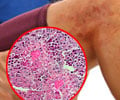- Compound from coralberry leaves called FR900359 (FR) proved to prevent bronchial muscle contraction in rat, pig and human cells ex-vivo and asthmatic rat models in-vivo.
- FR’s mechanism of action is similar to currently available drugs, which inhibit G protein activity.
- FR selectively inhibits Gq protein which suggested to be a useful therapeutic for broncho-constriction in asthmatic lung disease.
Significance of the Study
People with asthma regularly suffer from airway constriction preventing adequate ventilation of the lungs. The constriction is a result of bronchial muscle contraction in these patients. This results in shortness of breath, that may become life threatening, if not controlled. The novel compound, FR, is effective in preventing the bronchial muscle from contracting and relieving spasms. Authors also claim that FR is more effective and has a prolonged time of action compared to the commonly used drug salbutamol. Although the FR treatment worked exceptionally well in mice, a lot of testing needs to be further done before human clinical trials.Mechanism of Action of FR
Narrowing of airways leading to shortness of breath is a result of several signaling pathways within the body. Inhibition of these signaling pathways can reduce contraction of the respiratory tract. But in patients with severe asthma, this doesn’t seem to prevent the contractions.Current drugs work by inhibiting a single pathway that results in airway constriction. However, various contracting signals converge on a signaling protein called Gq. This convergence ultimately leads to spasms.
In the airways, Gq-coupled G protein coupled receptors (GPCRs) are thought to play an important role in controlling the tone of airway smooth muscle. FR works by specifically inhibiting Gq thereby inhibiting it from further triggering contractions.
"When we inhibit the activation of Gq proteins with FR900359, we achieve a much greater effect," emphasizes Dr. Michaela Matthey, first author of the study.
Benefit Over Current Drugs
Current treatment options focus on inhibiting a single GPCR at one time. In more severely affected patients, a combination of different drugs is used to inhibit the different pathways. Also, there arise concerns over long term usage of certain medications combined with poor disease control.This means that there is a sub group of patients, who are partially or completely not responding to current GPCR based therapy,
FR based therapy in mouse has proved that the side effects of the treatment are minimal. In fact, the study shows that in the lungs of mice that inhaled FR, airway constriction was prevented with no acute changes in heart rate and blood pressure.
Future Course of Action
Although scientists have been able to show that bronchial muscle cells isolated from human lungs also inhibit constriction when treated with FR, it could take years before we reach human trials.Reference:
- Matthey, M., Roberts, R., Seidinger, A., Simon, A., Schröder, R., Kuschak, M., Annala, S., König, G., Müller, C., Hall, I., Kostenis, E., Fleischmann, B. and Wenzel, D. (2017). Targeted inhibition of G q signaling induces airway relaxation in mouse models of asthma. Science Translational Medicine, 9(407), p.eaag2288.














